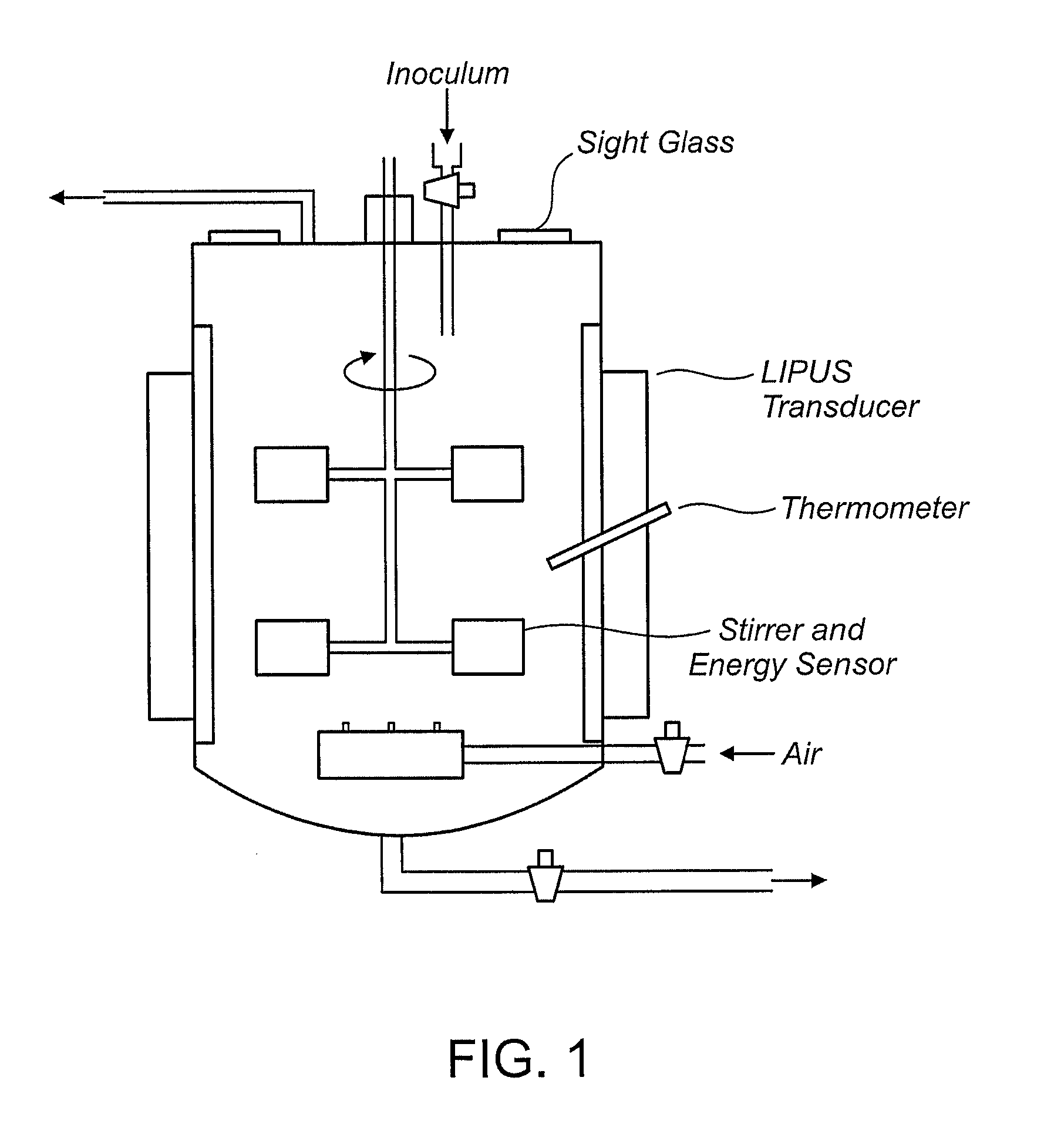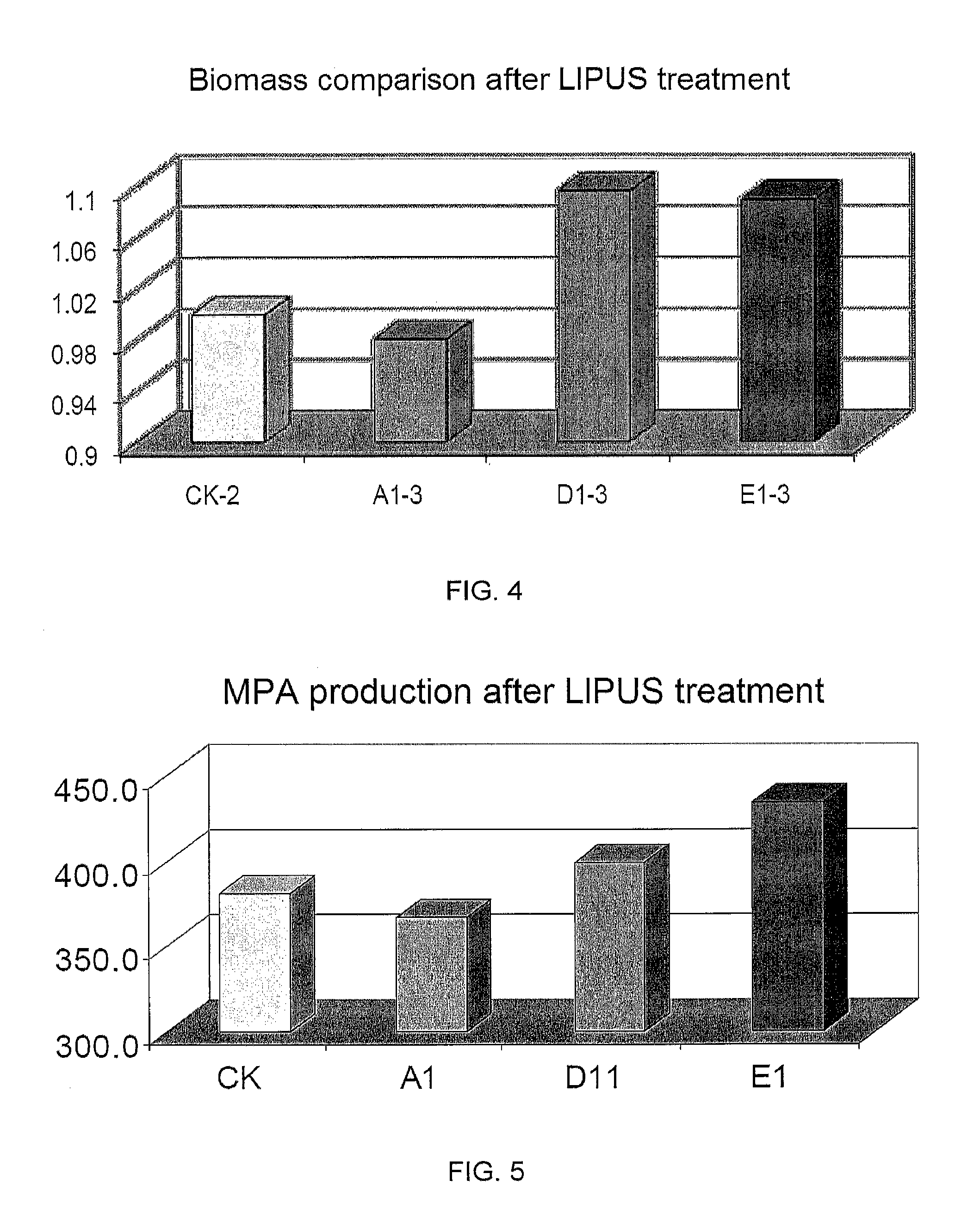Ultrasound enhanced growth of microorganisms
a microorganism and ultrasonic technology, applied in the field of ultrasonic enhanced growth of microorganisms, can solve the problems of slow growth rate, difficult hydrolysis into individual glucose, negative impact on food industry, etc., to increase the rate of growth of microorganisms, enhance the production of useful products and/or protein expression, and increase the growth rate
- Summary
- Abstract
- Description
- Claims
- Application Information
AI Technical Summary
Benefits of technology
Problems solved by technology
Method used
Image
Examples
example 1
Growth of Penicillium brevicompactum
[0069]P. brevicompactum strain was obtained from Apotex Fermentation Inc. (Winnipeg, Canada). One vial of cryopreserved P. brevicompactum spores was diluted with sterile water (1:20). 1 ml of the spore suspension was dispensed into a 500 ml flask containing 75 ml of potato dextrose agar (PDA) and incubated for 9 days at room temperature. 50 ml of sterile 0.01% Tween™ 80 was added to the spore culture flask and the spores were scraped into solution. The solution was transferred to a sterile container. 200 μL, of the spore suspension was inoculated into a 125 ml plastic flask with 25 ml seed medium. The seed flasks were incubated at 27° C., 200 rpm (2″ throw) for 48 hours. 0.5 ml of seed culture was inoculated into flasks containing 25 ml production medium and incubated at 27° C., 200 rpm (2″ throw).
[0070]For Examples 4-5, P. brevicompactum culture was maintained on a PDA plate. For inoculation, ceorangiospores were washed from the PDA plate with s...
example 2
MPA Quantitation by HPLC
[0077]Calibration and quality control standards were prepared by dilution of MPA stock solution with acetonitrile. Calibration standards containing 0.5, 1.0, 10, 50, 100, 250, 500 μg / ml MPA were used to construct a calibration curve using 1 / ×2 linear regression.
[0078]HPLC was performed using an Agilent 1100 HPLC system (Agilent Technologies, Waldbronn, Germany). The analytical column was a SymmetryShield™ RP8, 100×4.6 mm, 3.5 μm column (WAT094275, Waters Corporation, Milford, Mass.) with a SymmetryShield™ 3.9×20 mm, 5 μm guard column (WAT200675, Waters Corporation). The mobile phase consisted of buffer A (5 mM NaH2PO4 solution and methanol at a ratio of 13:7 v / v) and buffer B (2.5 mM NaH2PO4 solution and methanol at a ratio of 1:9 v / v). The pH was adjusted to 4.0 using 1.0 M phosphoric acid. Elution of MPA from the column was carried out with a linear gradient mobile phase at a flow rate of 1.0 ml / min from 0 to 80% B in 8 min, from 80% to 100% B in 4 min, 100...
example 3
Higher Intensity Ultrasound
[0080]Certain higher levels of ultrasound treatment may suppress cell growth. P. brevicompactum treated with 80 mW / cm2 showed a slight decrease in biomass and MPA production under the specific growth conditions used, whereas ultrasound at 30 and 60 mW / cm2 showed increases in biomass and MPA production (FIGS. 4 and 5).
PUM
| Property | Measurement | Unit |
|---|---|---|
| frequency | aaaaa | aaaaa |
| frequency | aaaaa | aaaaa |
| frequency | aaaaa | aaaaa |
Abstract
Description
Claims
Application Information
 Login to View More
Login to View More - R&D
- Intellectual Property
- Life Sciences
- Materials
- Tech Scout
- Unparalleled Data Quality
- Higher Quality Content
- 60% Fewer Hallucinations
Browse by: Latest US Patents, China's latest patents, Technical Efficacy Thesaurus, Application Domain, Technology Topic, Popular Technical Reports.
© 2025 PatSnap. All rights reserved.Legal|Privacy policy|Modern Slavery Act Transparency Statement|Sitemap|About US| Contact US: help@patsnap.com



